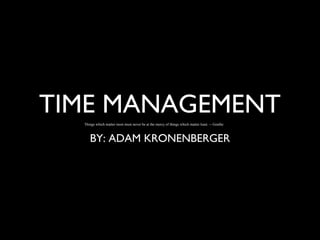Biz time managment
•Télécharger en tant que PPT, PDF•
10 j'aime•3,626 vues
Signaler
Partager
Signaler
Partager

Recommandé
Recommandé
Contenu connexe
Tendances
Tendances (20)
23 Time Management Techniques of Insanely Busy People

23 Time Management Techniques of Insanely Busy People
En vedette
En vedette (16)
7 time management attitude to boost your creativity

7 time management attitude to boost your creativity
Similaire à Biz time managment
Similaire à Biz time managment (20)
Planning, prioritising and efficiency: a Time Management Workshop

Planning, prioritising and efficiency: a Time Management Workshop
Dernier
Dernier (20)
08448380779 Call Girls In Diplomatic Enclave Women Seeking Men

08448380779 Call Girls In Diplomatic Enclave Women Seeking Men
Automating Google Workspace (GWS) & more with Apps Script

Automating Google Workspace (GWS) & more with Apps Script
Scaling API-first – The story of a global engineering organization

Scaling API-first – The story of a global engineering organization
How to Troubleshoot Apps for the Modern Connected Worker

How to Troubleshoot Apps for the Modern Connected Worker
Workshop - Best of Both Worlds_ Combine KG and Vector search for enhanced R...

Workshop - Best of Both Worlds_ Combine KG and Vector search for enhanced R...
Strategize a Smooth Tenant-to-tenant Migration and Copilot Takeoff

Strategize a Smooth Tenant-to-tenant Migration and Copilot Takeoff
Strategies for Unlocking Knowledge Management in Microsoft 365 in the Copilot...

Strategies for Unlocking Knowledge Management in Microsoft 365 in the Copilot...
Boost Fertility New Invention Ups Success Rates.pdf

Boost Fertility New Invention Ups Success Rates.pdf
[2024]Digital Global Overview Report 2024 Meltwater.pdf![[2024]Digital Global Overview Report 2024 Meltwater.pdf](data:image/gif;base64,R0lGODlhAQABAIAAAAAAAP///yH5BAEAAAAALAAAAAABAAEAAAIBRAA7)
![[2024]Digital Global Overview Report 2024 Meltwater.pdf](data:image/gif;base64,R0lGODlhAQABAIAAAAAAAP///yH5BAEAAAAALAAAAAABAAEAAAIBRAA7)
[2024]Digital Global Overview Report 2024 Meltwater.pdf
ProductAnonymous-April2024-WinProductDiscovery-MelissaKlemke

ProductAnonymous-April2024-WinProductDiscovery-MelissaKlemke
Understanding Discord NSFW Servers A Guide for Responsible Users.pdf

Understanding Discord NSFW Servers A Guide for Responsible Users.pdf
2024: Domino Containers - The Next Step. News from the Domino Container commu...

2024: Domino Containers - The Next Step. News from the Domino Container commu...
The 7 Things I Know About Cyber Security After 25 Years | April 2024

The 7 Things I Know About Cyber Security After 25 Years | April 2024
08448380779 Call Girls In Greater Kailash - I Women Seeking Men

08448380779 Call Girls In Greater Kailash - I Women Seeking Men
Axa Assurance Maroc - Insurer Innovation Award 2024

Axa Assurance Maroc - Insurer Innovation Award 2024
Biz time managment
- 1. TIME MANAGEMENT Things which matter most must never be at the mercy of things which matter least. -- Goethe BY: ADAM KRONENBERGER
- 2. Project Purpose • To evaluate self efficiency by: • • • 1st. Recording every event in a two day time frame. 2nd. Analyzing each event and where they classify on the time management quadrant. 3rd. Reflecting on the gathered information and possible improvements.
- 3. What is Time Management? • • • • Preserving and enhancing relationships and on accomplishing results. Begin with the end in mind. Focuses on what you want to be and to do and on the values or principles upon which being and doing are based. Covey, Stephen. The 7 Habits of Highly Effective People. London: Simon & Schuster, 1999. Print.
- 4. Time Management Quadrants Important Not Important I. Important/Urgent Crises; Pressing problems; Deadline-driven projects. II. Important/Not Urgent Centered Activities; Planning; Prevention; Relationship building; Opportunity Recognition; True Recreational Activities. III. Not Important/Urgent Imminent pressing matters; "Popular" Activities (i.e., activities that you think will make you popular with others); Personal Interruptions; Some calls and mail; Certain meetings and reports. IV. Not Important/Not Urgent Time wasters; So called "Pleasant" activities that are not really pleasant (e.g., drinking to excess) that are actually escapes from responsibilities. Trivia, busy work. Some types of mail/phone calls. This quadrant is used to compare what task are being done with there relevant importance to achieving personal objectives.
- 5. Day One RESULTS Day one tasks classified by four quadrants. These results show that a majority of my time was spent in quadrant two. TWO Centered Activities; Planning; Prevention; Relationship building; Opportunity Recognition; True Recreational Activities.
- 6. Day Two RESULTS Day two tasks classified by four quadrants. These results show that my overall activity in quadrants three and four increased. THREE Imminent pressing matters; "Popular" Activities (i.e., activities that you think will make you popular with others); Personal Interruptions; Some calls and mail; Certain meetings and reports. FOUR Time wasters; So called "Pleasant" activities that are not really pleasant (e.g., drinking to excess) that are actually escapes from responsibilities. Trivia, busy work. Some types of mail/phone calls.
- 7. New Information Average of day one and day two Facts: •About 60% of my time is productive. •About 10% of my time is a complete waste. •About 20% could be spent more wisely.
- 8. Strength •The reason I spent allot of my time in Quadrant Two is because I prioritize all tasks. •I set deadlines and make sure I complete at least halve the project well before my deadline. •I constantly make lists of small things to do each day, and longterm lists to keep track of goals. •When working on long term goals I divide them into tasks that can be completed quickly.
- 9. Weakness • • • • • Procrastination, leaving important tasks little time to be done. Rewarding myself to often Trivial Work Activities that escape me from responsibilities Getting caught up in the small details
- 10. Conclusion • Facts learned • • • 60% of my time is spent efficiently 20% of my time is wasted Action to be taken • It is necessary that I remove myself from situations that build relationships but cost me valuable time to achieve important tasks.
Notes de l'éditeur
- {}